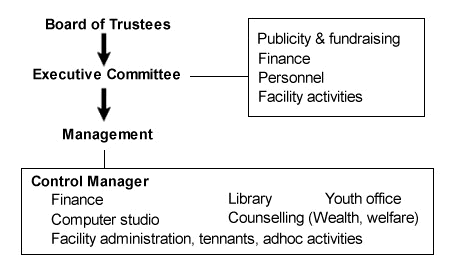This
management structure consists of:
- A board
of trustees who are responsible for
the management of Trust funds and
broader corporate funding. This
board can consist of members of local
business who have access or funding
connections, your local government as a
funding and input source, senior leaders
within the community and ex-officio
members of management such as a senior
accounting and general management
employee.
- An executive
committee with various
sub-committees focusing on issues relating to the day to day functioning of the facility such as facility activities, administration,
staff, etc. The members of the executive would ideally consist of a variety of role players in the community coming from a cross-section of interests such as the aged, youth, health, women, sports associations, disabled, etc. There could be representatives from your
permanent tenants or casual facility users. The committee should have co-option powers in order to include persons where particular expertise are needed.
- A Management team handles the day to day running of the facility. Being ”hands on” experts they also provide input to the committees they serve on. The management team is your full-time paid employees. In a small indoor facility there may be a manager, receptionist and cleaning
staff. In a larger facility the manager may supervise a security team,
cleaners, reception and accounts. An outdoor facility may only require a
general keeper. There could be project/cost facility managers, as in a multi- purpose resource facility that provide additional services such as a library, career guidance, counselling, computer training and youth services.

Legal
Governances Structures
In all cases it is advisable to get additional assistance from professionals to help you set up your particular structure.
These
structures offer options both to local government that would
like to be more inclusive in their governance and to communities who own a facility in its entirety.
A partnership, therefore, with local government to assist with
running costs.
With an existing facility belonging to local government, current government legislation states that the fixed assets of the building
/playing courts are retained as the property of local government and facility usage should remain within the general purpose for which it was originally built. Local
government could retain responsibility for basic salaries, repairs
and maintenance.
Where a
non-governmental
organisation (NGO) owns a facility, a partnership with local government must be encouraged. This could be advantageous to
local government if they have been saved the original expense of putting up
the facility in a needy area. By forming a partnership with the NGO and allowing the NGO to continue to fund raise for special projects, they would be able to increase the capacity of the facility to serve the local community to best
effect. Local government would then earn some seats on the new legal structure chosen because of their contribution. Examples of Legal
Governance Structures:
Voluntary association
A voluntary association is an association of persons who share a common objective. It can be social, humanitarian, educational, sporting, political, scientific or religious. The rights and obligations of the association ore
regulated through its constitution and special resolutions.
The formation of this association is the most simple of the three structures and is the least formal method of being constituted. It’s not monitored by a
statutory authority, and not always acceptable to the institutional and corporate donor. A sports or cultural federation that
attracts a particular group of people who share a common interest and who then e.g. pay membership
fees towards the upkeep of their federation, can be classified as a voluntary
association. The executive committee elected by the members manages the
association within the guidelines of their constitution.
Trust
A donor may decide to form a trust for a specific purpose. Donate cash or property to another person (trustee) via a trust to be administered for the benefit of beneficiaries. A bank may for example donate funds to the Sports Trust, that distributes these funds to a select group of beneficiaries
/individuals, The Trust is registered with the Master of the Supreme Court who may impose strict
financial control over the Trust and could monitor the activities of the Trust. There are rules on who may be a Trustee (person that sits on the executive committee of the Trust),
ensuring the person is of good standing.
Continue to Section 21 company or an
association not for gain
|